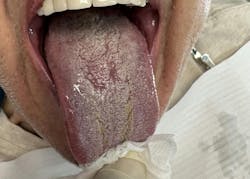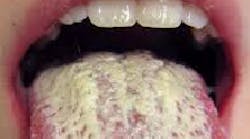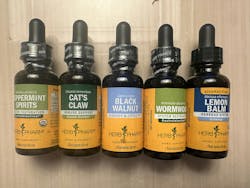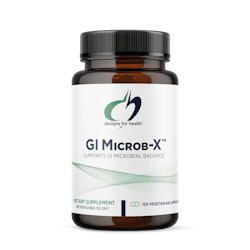Herbal treatments for oral thrush and small intestinal fungal overgrowth
In the realm of dental and gastrointestinal health, combating fungal infections such as oral thrush and small intestinal fungal overgrowth (SIFO) is paramount. While antifungal medications are traditionally prescribed, there is a growing interest in herbal treatments due to their efficacy and reduced side effects. This article explores various herbs that have demonstrated potential in treating Candida infections and provides insights into their mechanisms of action, supported by clinical evidence.
Understanding Candida infections
Oral thrush
Primarily caused by the overgrowth of Candida albicans, oral thrush manifests as white lesions on the tongue and inner cheeks (figure 1). It’s a common condition, especially among immunocompromised individuals, those with diabetes, xerostomia (dry mouth), nutritional deficiencies, patients with removable dentures, and those using antibiotics or corticosteroids.
Symptoms of oral thrush include1:
- Halitosis
- White patches on the tongue, inner cheeks, and sometimes on the roof of the mouth, gums, and tonsils that bleed when wiped away
- Redness, burning, or soreness
- Cotton (dry) mouth
- Loss of taste
- Pain while eating or swallowing
- Cracking and redness at the corners of the mouth
- Redness, irritation, and pain under dentures (denture stomatitis)
Small intestinal fungal overgrowth
SIFO, though less commonly discussed, involves the excessive growth of fungal organisms in the small intestine. Symptoms often mimic those of irritable bowel syndrome (IBS), including halitosis, bloating, gas, diarrhea, flatulence, and abdominal pain.2
The efficacy of herbal treatments
Herbal remedies offer a promising alternative to conventional antifungals. Antifungals such as nystatin and ketoconazole, although effective, have been associated with gastrointestinal upset, rash, dizziness, abdominal pain, and liver toxicity.3 Below, we’ll discuss several herbs with notable antifungal properties.
Oregano oil
Oregano oil, rich in compounds like carvacrol and thymol, has potent antifungal properties. Studies suggest it can disrupt the cell membranes of fungi, leading to their death.4 Its effectiveness is comparable to traditional antifungal drugs, but with fewer side effects.5
Cat’s claw
Cat’s claw, derived from the bark of a vine found in the Amazon rainforest, is known for its immune-boosting properties. It contains compounds that inhibit the growth of Candida species, making it a valuable herb in managing fungal infections. In one human study, a 2% extract of cat’s claw gel was as effective as a 2% miconazole gel in reducing Candida overgrowth.6
Wormwood
Wormwood (Artemisia absinthium), often associated with treating parasitic infections, also exhibits antifungal activity. It interferes with the metabolic processes of Candida, thereby inhibiting its growth. One study demonstrated that artemisinin, derived from wormwood, interacts with mitochondria in Candida cells. This interaction disrupts mitochondrial function, leading to fungal cell death. The study underscores wormwood’s potential in managing fungal infections.7
Berberine and Phellodendron
Berberine, found in several plants including goldenseal and barberry, has demonstrated significant antifungal activity. It disrupts the biofilm formation of Candida, a key factor in its pathogenicity. Its broad-spectrum antimicrobial properties make berberine a versatile herb for treating fungal infections.8 Similarly, Phellodendron, a traditional Chinese medicinal herb, contains berberine and has shown effectiveness against Candida species, making it a potential candidate for treating oral thrush and SIFO.
Turmeric
Turmeric, renowned for its anti-inflammatory properties, also possesses antifungal activity. Turmeric disrupts fungal plasma membranes and can alter the morphology of hyphae, causing them to collapse. Turmeric can also destroy fungal mitochondria, highlighting its potential as a safe and effective antifungal treatment option.9
Conclusion
Herbal treatments offer a promising alternative to traditional antifungal medications for managing oral thrush and SIFO. Herbs like oregano oil, cat’s claw, wormwood, Phellodendron, berberine, and turmeric have demonstrated efficacy in inhibiting fungal growth. Supported by clinical evidence, these herbs not only provide effective treatment options but also minimize the risk of adverse side effects commonly associated with conventional antifungals.
For dental professionals seeking holistic and integrative approaches to treating fungal infections, incorporating these herbs into patient care protocols could be highly beneficial and offer patients effective and safer alternatives, ultimately enhancing their overall well-being and quality of life. These herbal supplements can be bought individually and taken sublingually (figure 2) or can be combined and placed in pill form (figure 3).
Editor’s note: This article originally appeared in Perio-Implant Advisory, a chairside resource for dentists and hygienists that focuses on periodontal- and implant-related issues. Read more articles and subscribe to the newsletter.
References
- Oral thrush. Mayo Clinic. April 23, 2021. https://www.mayoclinic.org/diseases-conditions/oral-thrush/symptoms-causes/syc-20353533
- Erdogan A, Rao SSC. Small intestinal fungal overgrowth. Curr Gastroenterol Rep. 2015;17(4):16. doi:10.1007/s11894-015-0436-2
- Benitez LL, Carver PL. Adverse effects associated with long-term administration of azole antifungal agents. Drugs. 2019;79(8):833-853. doi:10.1007/s40265-019-01127-8
- Leyva-López N, Gutiérrez-Grijalva EP, Vazquez-Olivo G, Heredia JB. Essential oils of oregano: biological activity beyond their antimicrobial properties. Molecules. 2017;22(6):989. doi:10.3390/molecules22060989
- Pozzatti P, Scheid LA, Spader TB, Atayde ML, Santurio JM, Alves SH. In vitro activity of essential oils extracted from plants used as spices against fluconazole-resistant and fluconazole-susceptible Candida spp. Can J Microbiol. 2008;54(11):950-956. doi:10.1139/w08-097
- Moraes RC, Lana AJD, Kaiser S, Carvalho AR, Oliveira L, Fuentefria A, Gonzalez Ortega G. Antifungal activity of Uncaria tomentosa (Willd.) D.C. against resistant non-albicans Candida Ind Crops Prod. 2015;69:7-14. doi:10.1016/j.indcrop.2015.01.033
- Li W, Mo W, Shen D, et al. Yeast model uncovers dual roles of mitochondria in action of artemisinin. PLoS Genet. 2005;1(3):e36. doi:10.1371/journal.pgen.0010036
- da Silva AR, de Andrade Neto JB, da Silva CR, et al. Berberine antifungal activity in fluconazole-resistant pathogenic yeasts: action mechanism evaluated by flow cytometry and biofilm growth inhibition in Candida spp. Antimicrob Agents Chemother. 2016;60(6):3551-3557. doi:10.1128/AAC.01846-15
- Murugesh J, Annigeri RG, Mangala GK, Mythily PH, Chandrakala J. Evaluation of the antifungal efficacy of different concentrations of Curcuma longaon Candida albicans: An in vitro study. J Oral Maxillofac Pathol. 2019;23(2):305. doi:10.4103/jomfp.JOMFP_200_18
About the Author

Scott Froum, DDS
Editorial Director
Scott Froum, DDS, a graduate of the State University of New York, Stony Brook School of Dental Medicine, is a periodontist in private practice at 1110 2nd Avenue, Suite 305, New York City, New York. He is the editorial director of Perio-Implant Advisory and serves on the editorial advisory board of Dental Economics. Dr. Froum, a diplomate of both the American Academy of Periodontology and the American Academy of Osseointegration, is a volunteer professor in the postgraduate periodontal program at SUNY Stony Brook School of Dental Medicine. He is a PhD candidate in the field of functional and integrative nutrition. Contact him through his website at drscottfroum.com or (212) 751-8530.





